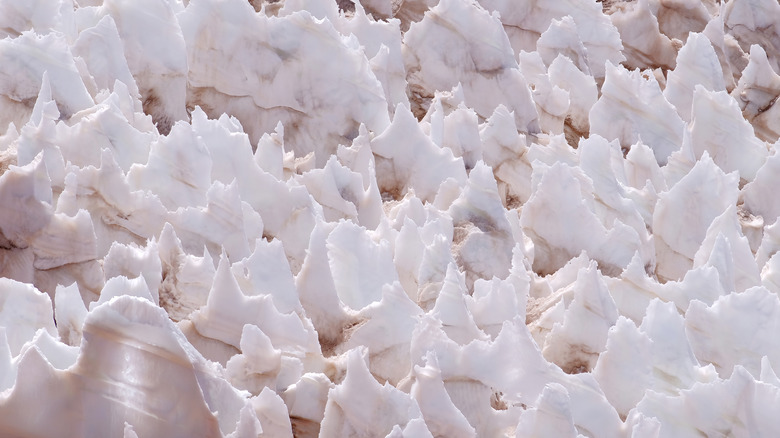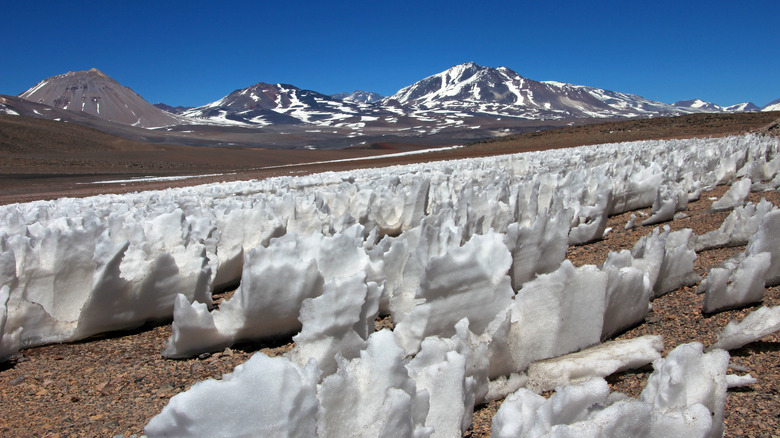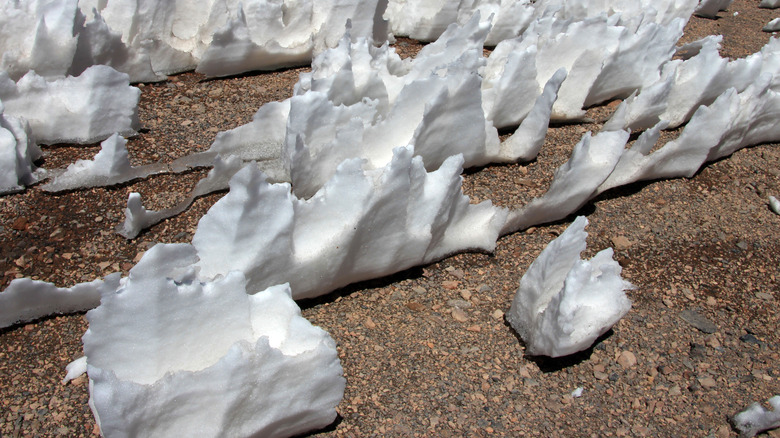Everything We Know About Penitentes, Aka Ice Spikes
Just when you think nature can't surprise you anymore, it still manages to find a way to do so.
Up in the tall peaks of the Andes Mountains are fascinating formations standing watch over everything. These look like blades of snow jutting up from the ground as if reaching toward the sun or waiting for someone to roll down and cut them accidentally. Researchers called them penitentes, or nieves penitentes, after the Spanish word for penitents during Holy Week.
Charles Darwin first described these beautiful and somewhat shocking figures on the tops of mountains in the 1800s, Newsweek reported.
According to Amusing Planet, Darwin journeyed from Santiago, Chile, to the Argentine city of Mendoza in March 1835. To get there, he squeezed through the Andes and found fields covered with penitentes near the Piuquenes Pass. At the time, he said the ice was probably formed by strong winds rolling through the mountains, based on local beliefs.
Penitentes do look like blades. They often grow in clusters, with some only a few inches tall but others growing as high as 16 feet. Sometimes they cover entire snowfields, but they can also be found in patches. Yet, they're always reaching for the sun.
For several years, penitentes remained a mystery. The formations were only observed in hard-to-reach regions. These areas are cold, dry, windy, and not very conducive to sustaining life. It was too hard to conduct a close study of the natural phenomenon.
It's all thanks to sublimation
However, scientists are never people who just give up, so they've managed to trek up to the high reaches of the Andes to study the stunning formations.
Newsweek reported that researchers hiked up to the Volcan Llullaillaco to observe the penitentes. One scientist said they made sure their trucks had tons of water, so no one became dehydrated, which is why it was hard to study them in the first place.
A paper from the Journal of Glaciology noted penitentes do form in areas outside the Andes. Small ice spikes have also been found along Route 66 in Missouri, especially after heavy snowfall followed by dry, windy days. Although, the conditions are perfect in the Andes to grow the most outstanding examples of penitentes.
It turns out penitentes are formed thanks to a bunch of natural processes. One is sublimation, or when a solid turns to gas without becoming a liquid, kind of like dry ice. Per Amusing Planet, snowfields are not perfectly flat. Some areas concentrate sunlight and sublimate faster than others and leaves behind the snow surrounding it as spikes. The Journal of Glaciology added that the penitentes continue to grow and point to a cycle of evaporation and redeposition on the blades.
Penitentes grow bigger if snow or the ground can trap higher amounts of radiation or sunlight, possibly why the Andes produce the most impressive examples.
So while there is a possible theory to how ice spikes form, researchers want to know more.
Ice spikes may hold the key to alien life
One observation people saw while studying penitentes is that it could offer a way to save the glaciers. ScienceDaily wrote researchers sprinkled some carbon on lab-grown penitentes and found it affected the melting process. Since penitentes disappear slower, this method could help save the melting glaciers. But, other academics argue that the presence of carbon might be the very reason why penitentes absorb sunlight in the first place.
That's not the only possible way penitentes are intriguing to scientists. Newsweek said researchers in the Andes found evidence penitentes had red ice patches, a sign that some form of microscopic life exists within the ice. Studies showed the ice contained snow algae and proved penitentes offer shelter and water to life in an otherwise harsh environment. This discovery not only reveals how life survives dangerous places, but also provides an excellent starting point to find life on other planets.
NBC said NASA satellites found evidence that Jupiter's ocean moon Europa had clusters of spiky ice below its frozen ocean. Europa, despite having an ocean, is very dry and cold, perfect conditions to create penitentes. And if penitentes on Earth can hold life, maybe the ones on Europa do as well.
So next time you want to be surprised at Mother Nature, maybe consider a trip to the Andes.


